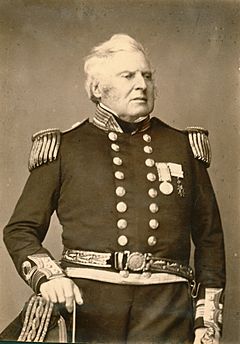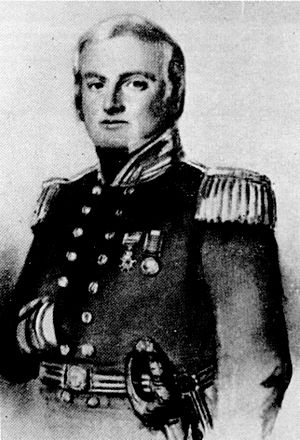John Hindmarsh facts for kids
Quick facts for kids
Rear Admiral
Sir John Hindmarsh
KH RN
|
|
|---|---|
 |
|
| 1st Governor of South Australia | |
| In office 28 December 1836 – 16 July 1838 |
|
| Monarch | William IV Victoria |
| Preceded by | Office established |
| Succeeded by | George Gawler |
| Personal details | |
| Born | 1785 Chatham, Kent Great Britain |
| Died | 29 July 1860 (aged 75) London, United Kingdom |
| Resting place | St. Andrew's Church, Hove |
| Occupation | Naval officer, Colonial administrator |
| Awards | Naval General Service Medal Knight of the Royal Guelphic Order |
| Military service | |
| Allegiance | Great Britain (1793–1801) United Kingdom (1801–1846) |
| Branch/service | |
| Years of service | 1793–1856 |
| Rank | Rear Admiral |
| Unit | HMS Bellerophon HMS Spencer HMS Victory HMS Phoebe HMS Beagle HMS Nisus HMS Scylla HMS Buffalo |
| Commands | HMS Scylla HMS Buffalo |
| Battles/wars | Glorious First of June Battle of 17 June 1795 Battle of the Nile Second Battle of Algeciras Battle of Trafalgar Battle of the Basque Roads Invasion of Java |
Sir John Hindmarsh (born in 1785, died in 1860) was an important naval officer. He became the very first Governor of South Australia. He served in this role from December 1836 to July 1838.
Contents
Early Life and Family Background
John Hindmarsh was born in Chatham, Kent, England. His father, also named John Hindmarsh, was a warrant officer in the Royal Navy. He served on a famous ship called the Bellerophon.
John Hindmarsh senior was the gunner on the Bellerophon. This was a very important job. Young John Hindmarsh was the eldest son of John and Mary Hindmarsh.
John Hindmarsh joined the Royal Navy when he was very young, possibly around seven or eight years old. He was listed as a servant to his father on the ship Bellerophon. He even went to school on the ship!
Early Battles and Bravery
Hindmarsh saw his first action in 1794 at the Battle of the Glorious First of June. He was only nine years old. For his brave actions, he was promoted to First Class Volunteer.
He also fought in the Battle of the Nile in 1798. During this battle, his ship, the Bellerophon, was in danger. All the other officers on the deck were hurt. Young Hindmarsh, who was only 13, quickly gathered some crew members. He helped move the ship to safety.
Admiral Horatio Nelson heard about Hindmarsh's bravery. Five years later, Nelson promoted him to lieutenant. Hindmarsh was injured during the Battle of the Nile. He later lost an eye because of this injury.
Later Service and Promotions
Hindmarsh continued to serve in many important battles. He was at the Battle of Algeciras Bay in 1801. He also fought at the famous Battle of Trafalgar in 1805.
He was first lieutenant on the ship Beagle during the Battle of the Basque Roads in 1809. He also served in the invasion of Java in 1811. He was promoted to commander in 1814. Later, in 1831, he became a captain.
In 1836, Hindmarsh was chosen to be the first governor of a new colony. This colony was South Australia. He sailed there on HMS Buffalo.
In 1847, a special medal was created. It was called the Naval General Service Medal. This medal had clasps for each battle a person fought in. Only two people received this medal with seven clasps. Sir John Hindmarsh was one of them!
His seven clasps were for:
- Java
- Basque Roads 1809
- Trafalgar
- Gut of Gibraltar 12 July 1801 (Second Battle of Algeciras)
- Nile
- 17 June 1795 (Cornwallis's Retreat)
- 1 June 1794 (Glorious First of June)
He was promoted to rear admiral when he retired in 1856.
First Governor of South Australia
John Hindmarsh arrived in South Australia on 28 December 1836. He landed at Holdfast Bay in the ship Buffalo. Other ships had arrived earlier. These ships carried surveyors led by William Light. Their job was to find the best place for the new capital city.
Choosing the Capital City
Hindmarsh wanted the capital city to be at Port Lincoln. However, Colonel William Light chose a different location. He picked the site where Adelaide is today. This site was near Holdfast Bay, which is now called Glenelg. The city was named Adelaide after Queen Adelaide, the wife of King William IV.
The Proclamation of South Australia
On 28 December 1836, Governor Hindmarsh made an important announcement. This was called his Proclamation. It officially started the colonial government in South Australia.
In his proclamation, Hindmarsh said that Aboriginal people should be treated fairly. He stated they were "equally entitled to the privileges of British subjects." This meant they should have the same rights as British people. He promised to punish anyone who harmed them.
It's important to know that Hindmarsh's proclamation did not actually create the colony. The King had already done that in February 1836. The proclamation simply announced that the government was starting.
Challenges as Governor
As governor, Hindmarsh had some disagreements. He had conflicts with the Resident Commissioner, James Hurtle Fisher. These arguments became quite serious. Hindmarsh even suspended some public officers. Because of these problems, he was called back to London in 1838.
After leaving South Australia, Hindmarsh became Lieutenant-Governor of Heligoland in 1840. This is an island in the North Sea. He served there until 1857. Queen Victoria knighted him in 1851, giving him the title "Sir." He retired in 1857.
Legacy and Family Life
Sir John Hindmarsh died in London on 29 July 1860. He is buried in Hove, England.
He married Susanna Wilson Edmeades in 1809. They had several children. Some of his children and grandchildren became important figures. For example, his grandson, Alfred Humphrey Hindmarsh, became the first Labour leader in New Zealand.
Places Named After John Hindmarsh
Many places in Australia are named after Sir John Hindmarsh.
In Adelaide
- Hindmarsh Square, Adelaide is a public park in the city.
- The suburb of Hindmarsh was originally land he owned.
- The Governor Hindmarsh Hotel, or "The Gov," is a popular music venue.
- The Division of Hindmarsh is a federal election area.
In Regional South Australia
- The Hindmarsh River flows into Encounter Bay.
- Hindmarsh Island is near the town of Goolwa.
Other Locations
- Lake Hindmarsh is in western Victoria.
- Hindmarsh Drive is a road in Canberra.


